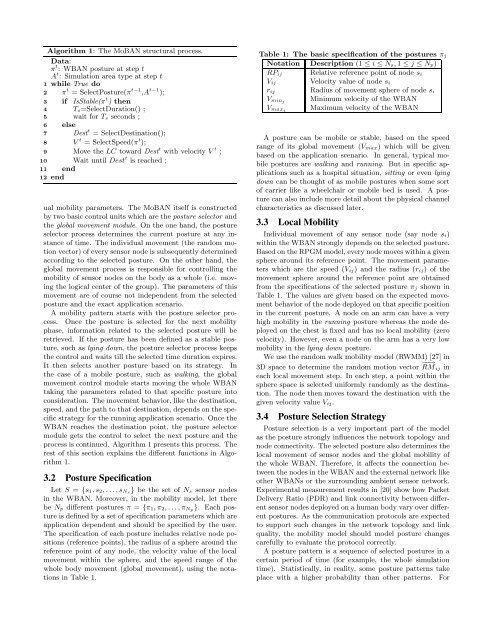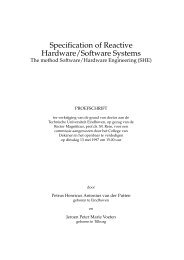MoBAN: A Configurable Mobility Model for Wireless Body Area ...
MoBAN: A Configurable Mobility Model for Wireless Body Area ...
MoBAN: A Configurable Mobility Model for Wireless Body Area ...
You also want an ePaper? Increase the reach of your titles
YUMPU automatically turns print PDFs into web optimized ePapers that Google loves.
Algorithm 1: The <strong>MoBAN</strong> structural process.<br />
Data:<br />
π t : WBAN posture at step t<br />
A t : Simulation area type at step t<br />
1 while True do<br />
π t = SelectPosture(π t−1 ,A t−1 2<br />
);<br />
if IsStable(π t 3<br />
) then<br />
4 Ts=SelectDuration() ;<br />
5 wait <strong>for</strong> Ts seconds ;<br />
6 else<br />
Dest t 7 = SelectDestination();<br />
V t = SelectSpeed(π t 8<br />
);<br />
Move the LC toward Dest t with velocity V t 9<br />
;<br />
Wait until Dest t 10<br />
is reached ;<br />
11 end<br />
12 end<br />
ual mobility parameters. The <strong>MoBAN</strong> itself is constructed<br />
by two basic control units which are the posture selector and<br />
the global movement module. On the one hand, the posture<br />
selector process determines the current posture at any instance<br />
of time. The individual movement (the random motion<br />
vector) of every sensor node is subsequently determined<br />
according to the selected posture. On the other hand, the<br />
global movement process is responsible <strong>for</strong> controlling the<br />
mobility of sensor nodes on the body as a whole (i.e. moving<br />
the logical center of the group). The parameters of this<br />
movement are of course not independent from the selected<br />
posture and the exact application scenario.<br />
A mobility pattern starts with the posture selector process.<br />
Once the posture is selected <strong>for</strong> the next mobility<br />
phase, in<strong>for</strong>mation related to the selected posture will be<br />
retrieved. If the posture has been defined as a stable posture,<br />
such as lying down, the posture selector process keeps<br />
the control and waits till the selected time duration expires.<br />
It then selects another posture based on its strategy. In<br />
the case of a mobile posture, such as walking, the global<br />
movement control module starts moving the whole WBAN<br />
taking the parameters related to that specific posture into<br />
consideration. The movement behavior, like the destination,<br />
speed, and the path to that destination, depends on the specific<br />
strategy <strong>for</strong> the running application scenario. Once the<br />
WBAN reaches the destination point, the posture selector<br />
module gets the control to select the next posture and the<br />
process is continued. Algorithm 1 presents this process. The<br />
rest of this section explains the different functions in Algorithm<br />
1.<br />
3.2 Posture Specification<br />
Let S = {s1, s2, . . . , sNs} be the set of Ns sensor nodes<br />
in the WBAN. Moreover, in the mobility model, let there<br />
be Np different postures π = {π1, π2, . . . , πNp}. Each posture<br />
is defined by a set of specification parameters which are<br />
application dependent and should be specified by the user.<br />
The specification of each posture includes relative node positions<br />
(reference points), the radius of a sphere around the<br />
reference point of any node, the velocity value of the local<br />
movement within the sphere, and the speed range of the<br />
whole body movement (global movement), using the notations<br />
in Table 1.<br />
Table 1: The basic specification of the postures πj<br />
Notation Description (1 ≤ i ≤ Ns,1 ≤ j ≤ Np)<br />
RPij Relative reference point of node si<br />
Vij Velocity value of node si<br />
rij Radius of movement sphere of node si<br />
Vminj Minimum velocity of the WBAN<br />
Maximum velocity of the WBAN<br />
Vmax j<br />
A posture can be mobile or stable, based on the speed<br />
range of its global movement (Vmax) which will be given<br />
based on the application scenario. In general, typical mobile<br />
postures are walking and running. But in specific applications<br />
such as a hospital situation, sitting or even lying<br />
down can be thought of as mobile postures when some sort<br />
of carrier like a wheelchair or mobile bed is used. A posture<br />
can also include more detail about the physical channel<br />
characteristics as discussed later.<br />
3.3 Local <strong>Mobility</strong><br />
Individual movement of any sensor node (say node si)<br />
within the WBAN strongly depends on the selected posture.<br />
Based on the RPGM model, every node moves within a given<br />
sphere around its reference point. The movement parameters<br />
which are the speed (Vij) and the radius (rij) of the<br />
movement sphere around the reference point are obtained<br />
from the specifications of the selected posture πj shown in<br />
Table 1. The values are given based on the expected movement<br />
behavior of the node deployed on that specific position<br />
in the current posture. A node on an arm can have a very<br />
high mobility in the running posture whereas the node deployed<br />
on the chest is fixed and has no local mobility (zero<br />
velocity). However, even a node on the arm has a very low<br />
mobility in the lying down posture.<br />
We use the random walk mobility model (RWMM) [27] in<br />
3D space to determine the random motion vector −−→<br />
RMij in<br />
each local movement step. In each step, a point within the<br />
sphere space is selected uni<strong>for</strong>mly randomly as the destination.<br />
The node then moves toward the destination with the<br />
given velocity value Vij.<br />
3.4 Posture Selection Strategy<br />
Posture selection is a very important part of the model<br />
as the posture strongly influences the network topology and<br />
node connectivity. The selected posture also determines the<br />
local movement of sensor nodes and the global mobility of<br />
the whole WBAN. There<strong>for</strong>e, it affects the connection between<br />
the nodes in the WBAN and the external network like<br />
other WBANs or the surrounding ambient sensor network.<br />
Experimental measurement results in [20] show how Packet<br />
Delivery Ratio (PDR) and link connectivity between different<br />
sensor nodes deployed on a human body vary over different<br />
postures. As the communication protocols are expected<br />
to support such changes in the network topology and link<br />
quality, the mobility model should model posture changes<br />
carefully to evaluate the protocol correctly.<br />
A posture pattern is a sequence of selected postures in a<br />
certain period of time (<strong>for</strong> example, the whole simulation<br />
time). Statistically, in reality, some posture patterns take<br />
place with a higher probability than other patterns. For

















